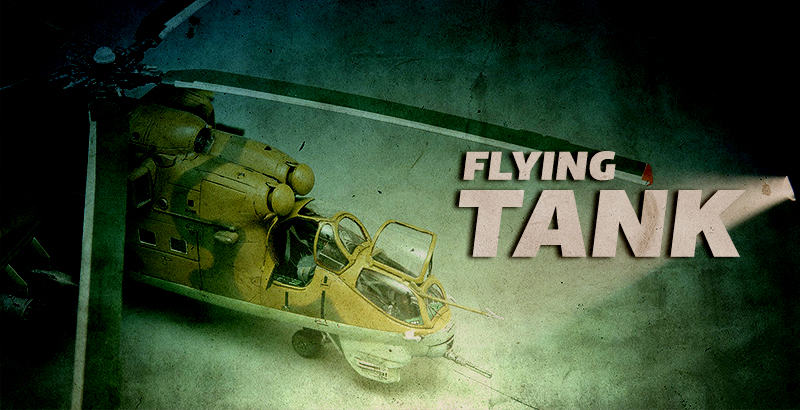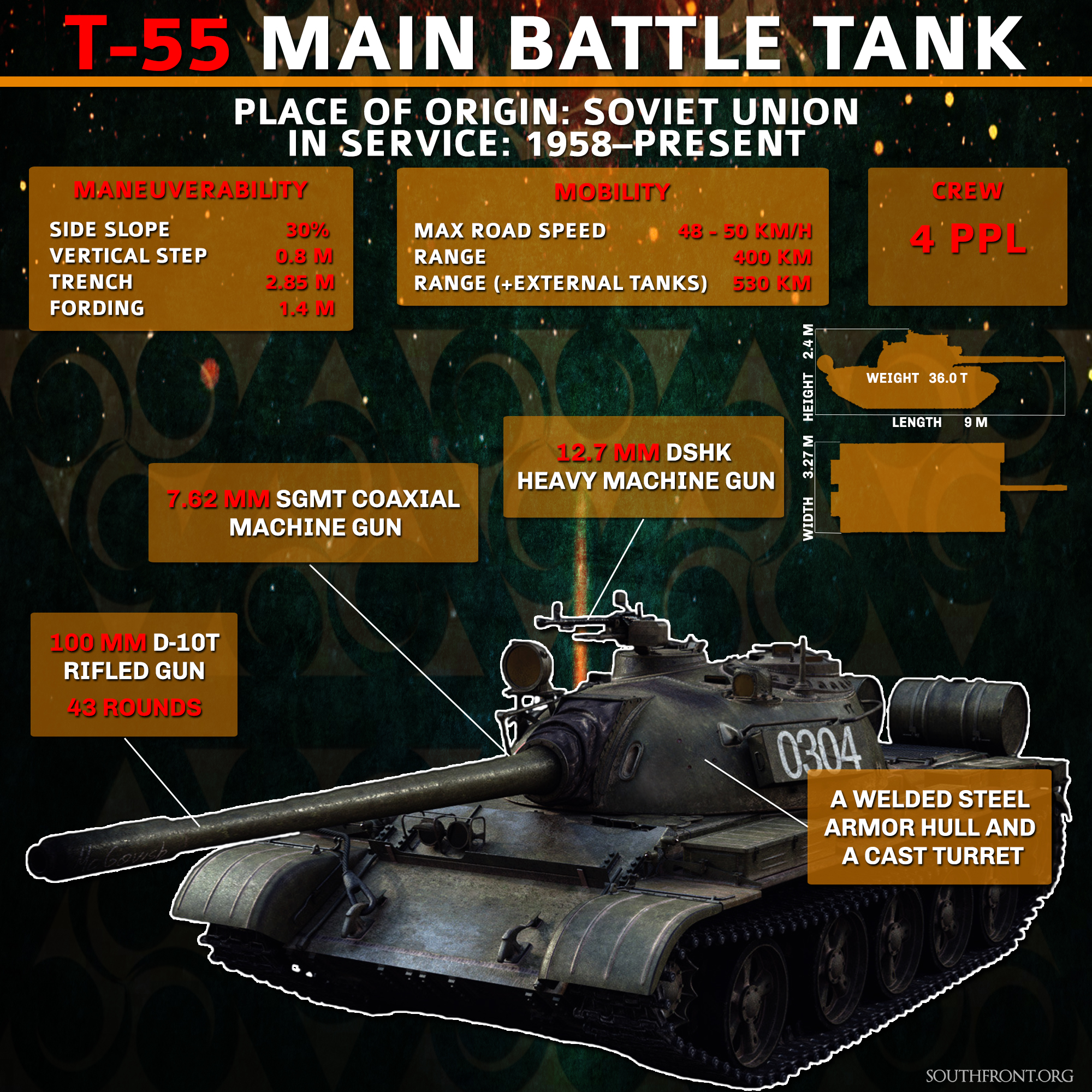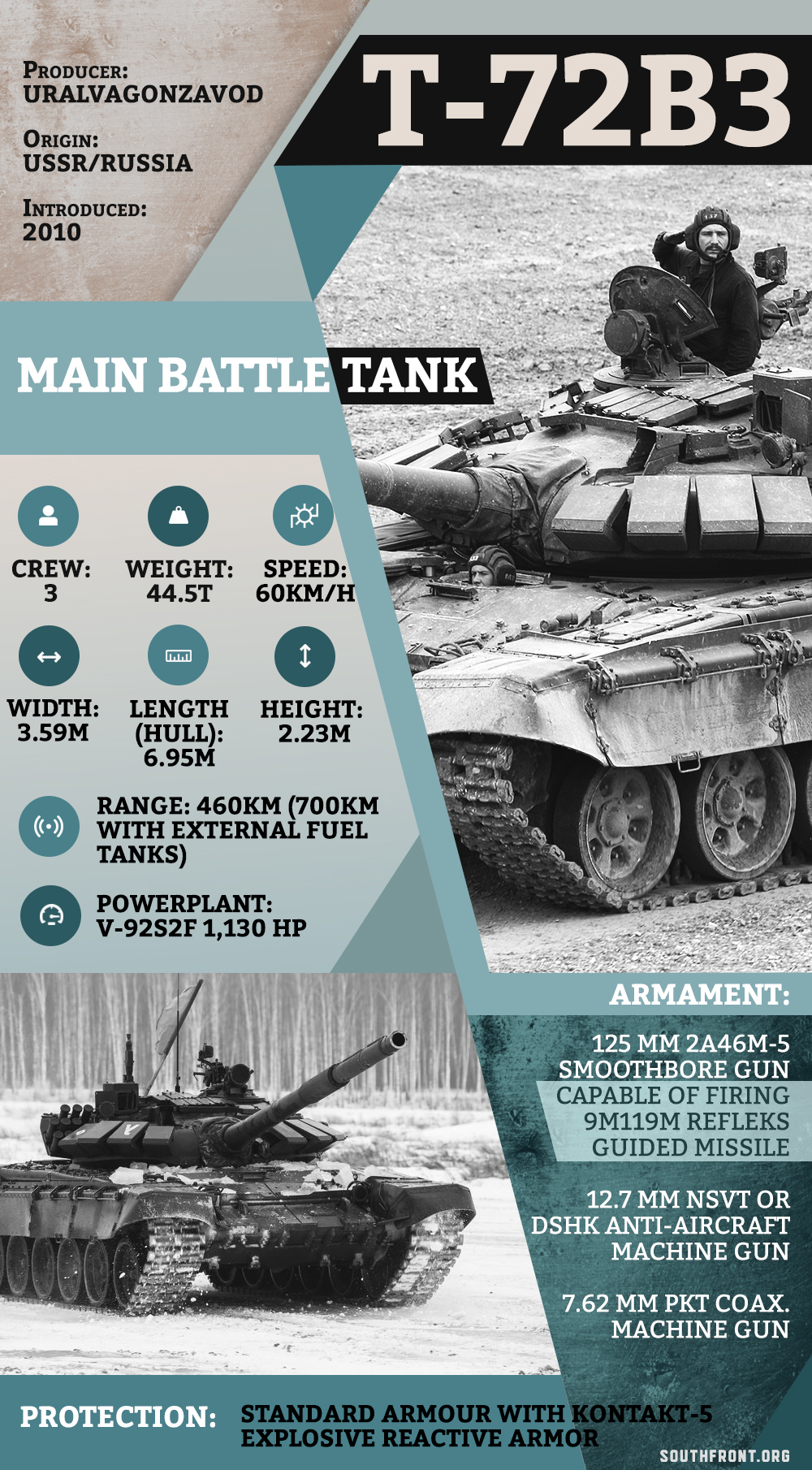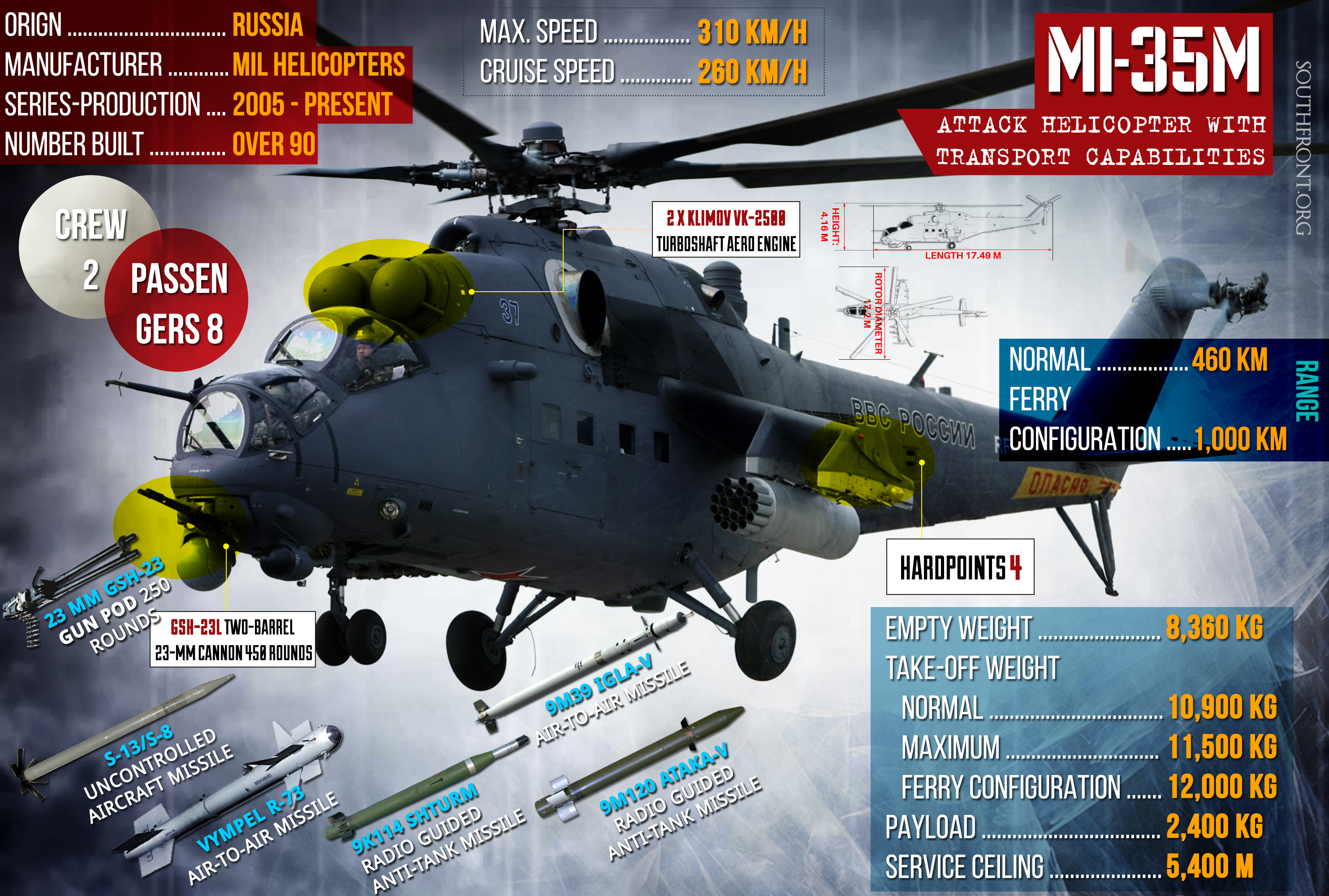Written by J.Hawk exclusively for SouthFront
It would seem that one of the first rule of early 21st century regional war is “Bring Lots of Russian Weapons”. Starting with small arms like the AK assault rifle family, the PKM general purpose machine-gun, and naturally the RPG-7 whose reputation is such that it entered common English-language use as “rocket-propelled grenade”, and ending with T-55 and T-72 tanks, BMP-1 and -2 infantry fighting vehicles, and the dreaded Mi-24 “Hind” family of attack helicopters, these are practically a staple of these wars and there is no prospect of that changing any time soon. While Russia is hardly the world’s biggest arms manufacturer, and these classes of weapons are manufactured in many other countries, there is not a single US, British, French, or German weapon that has reached the iconic status of the aforementioned Russian types. That is a remarkable state of affairs, since 100 years ago, in other words in 1920, Russia was not known as a global arms trendsetter that it is today, the benchmark against all others are compared.
The “Soviet school” of arms design and manufacture that is still unsurpassed today began its existence during Five-Year Plans of the 1930s which represent a crash program to industrialize and arm the Soviet state against the imminent threat of Nazi aggression in order to achieve the German Lebensraum, the blueprint for which was clearly spelled out in Hitler’s Mein Kampf published as early as 1925. The goal at the time was to design weapons, often on the basis of foreign examples, that would satisfy a tough set of criteria. First and foremost, the weapons had to be effective and competitive against what the adversaries would bring to the battlefield. Second, they had to be soldier-proof, in the sense of being rugged, reliable, and easily mastered by hastily mobilized reservists and even civilians that would flesh out the wartime Red Army. Third, they had to function well in every terrain and climate of the vast territory of USSR, including tundra, desert, swamps, and of course every infantryman’s ubiquitous friend—mud. Four, they were to be readily manufactured using relatively simple techniques, inexpensive materials, by a semi-skilled labor force, and remain operational even when operating at the end of a very tenuous logistical tether during prolonged, sustained warfare.
The record of the Great Patriotic War shows how successful Soviet engineers were in achieving these objectives, setting the stage for several decades of continued incremental and occasionally revolutionary progress in military technology which, no matter how sophisticated the weapon, these four sets of criteria have continued to inform Cold War era design priorities.
Fast-forwarding into the early 21st century, it turns out MENA regional conflicts are fought in the sort of conditions for which the 1930s Soviet engineers were preparing. Harsh environmental and climate conditions, tenuous logistics, hastily trained troops, absence of infrastructure, long-lasting conflicts—all of that is present in abundance in Syria, Yemen, Iraq, Libya, but also Afghanistan and even Ukraine.
By contrast, Western weapon systems are at their best when the situation is exactly the opposite: professional armies, fighting short wars, surrounded with ample infrastructure and receiving massive logistical support, ideally in not overly uncomfortable weather and terrain. In other words, US and European weapons are at their best when they are used in relatively short wars fought on the well paved over and densely populated European continent. When these conditions are met, Western weapons actually do outperform their Russian equivalents. When they are not, the performance gap closes and is even reversed, particularly when armored vehicles and helicopters are incapacitated due to lack of necessary maintenance and spare parts. Remarkably, this is not even a recent phenomenon. Napoleon Bonaparte’s military acumen was at its highest when his armies were operating on the network of Roman roads, ideally in agriculture-intensive provinces where his soldiers could “live off the land”. Once that built-in logistical support ended and Napoleon found himself operating in austere conditions of Spain, eastern Europe, and ultimately Russia, his army found itself out of its element. Napoleonic cavalry horses were as unacclimated to the harsh conditions of that early 19th century Eastern Front as German motorized units a century and a half later. Or NATO forces today.
The unsuitability of Western weapons for lengthy wars in austere conditions was made plain by the phenomenon of the FOB, or forward operating base, that has become the bane of existence of NATO armies and the subject of countless memes. US military personnel have even coined the term “fobbit” to describe those who spent their entire deployments in Iraq or Afghanistan on FOBs, without ever venturing “outside the wire”. NATO forces’ logistical requirements were so enormous that their mission quickly became “sustainment” and “force protection”, due to the need to protect the supply convoys feeding the FOBs. So many troops were tied down on these missions that the number of troops available for actual operations was only a small fraction of forces that at one time numbered over 100,000 troops.
Saudi Arabia and other Gulf Arab states quickly learned the same lesson during their disastrous campaign in Yemen. Saudi M1 Abrams tanks were theoretically more than a match for anything the Houthis put in the field, not that it made any difference because the fuel requirements of the 1,500 hp gas turbine operating in a hot and dusty environment were such that they proved the Saudis’ Achilles Heel. Time and again, rapid Saudi advances into Houthi territory first petered out and then had to retreat once the supply columns following the armored units were ambushed and destroyed. There is considerable photo and video evidence of Saudi tanks falling into Houthi hands because they banally ran out of fuel. Iraq’s own experience with the M1 was hardly more impressive, with the country eventually opting for supplies of T-90S tanks from Russia.
By contrast, various Libyan factions, the Houthi rebels, and of course the Syrian Arab Army have all managed to keep their T-55 and T-72 tanks operational for years on end, in difficult conditions and even before large-scale Russian involvement in Syria. Russia’s own operations in Syria have not degenerated into an exercise in sustaining and protecting bases. With only about 5,000 personnel in all of Syria as of early 2020, or half of the US and NATO contingent at the Bagram airbase in Kabul, Afghanistan, alone, Russian forces were able to accomplish a wide range of combat and support operations, in collaboration with Syrian and other allied forces, against tenacious foes far better equipped than the Taliban ever was and enjoying extensive Western financial and military support. While the Russian assistance mission was an eye-opener in many regards, in others it was a continuation of the long-standing Russian military culture of fighting prolonged conflicts in austere conditions.










good article..
https://uploads.disquscdn.com/images/4dbcad102334f653b1cad4d03637ec2685af917fd1428ac7fcef4a7644099fff.jpg
Russian Mikhail Kalashnikov invented the weapon that bears his name in the middle of the 20th
century. Born on Nov. 10, 1919, Kalashnikov was a tank mechanic in theSoviet military during the Second World War. He was wounded during the Nazi invasion of the USSR in 1941.
Having seen firsthand the combat advantage conferred by Germany’ssuperior firearms, Kalashnikov resolved to develop a better weapon.
While still in the military, he produced several designs that lost out to competitors before eventually producing the first AK-47.
The name of Kalashnikov’s greatest invention stands for Automat Kalashnikova 1947, the year it was first produced.
In 1949, the AK-47 became the assault rifle of the Soviet Army. Later adopted by other nations in the Warsaw Pact, the weapon quickly spreadaround the world, becoming a symbol of revolution in such far-flung lands as Vietnam, Afghanistan, Colombia, Mozambique and Hezbollah on whose flag it figures prominently.
The flag of Mozambique features an AK-47 with an attached bayonet, meant to symbolize defense and vigil.
Over the course of his long life, Kalashnikov continued to tweak his classic design. In 1959, production began on his AKM, which replaced the AK-47’s milled receiver with one made of stamped metal, making it both lighter and less expensive to produce. He also
developed the cartridge-fed PK machine gun. Modified AK-47s are still in production in countries around the world.
The AK-47’s advantages and abundance attest to its immoral design and performance. It has remained an icon for almost 75 years now.
It is relatively inexpensive to produce, short and light to carry,and easy to use, with little recoil. It also boasts legendary reliability under harsh conditions ranging from waterlogged jungles to Middle Eastern sandstorms, in both extreme cold and heat.
It also requires relatively little maintenance. This stems from its large gas piston and wide clearances between moving parts, which help to prevent it from jamming.
Kalashnikov liked to boast about the rifle’s superiority to the American military’s M-16 rifle.
“During the Vietnam War,” he said in a 2007 interview, “American soldiers would throw away their M-16s to grab AK-47s and bullets for it from dead Vietnamese soldiers. And I hear American soldiers in Iraq use it quite often.”
Indeed very nice design https://uploads.disquscdn.com/images/d056efd2551ad278faf23ee5bfd6bd09e6719257329bf15950d2229109aef256.jpg
The AR has more in common with the Stg-44 than the AK.
Isn’t AR semiautomatic?
It can be full auto or burst too.
Depends on the model.
M-16, M4 and every other iteration are part of the AR platform, the AR-15 included.
Thank captain
??
are you in military or that is just passion?
Passion.
But its nice to see ARs finally switching to gas piston systems instead of the DI.
Hk-416/M-27, Ruger-556 and Sig-516 are prime examples.
Similar appearance to AK but different mechanism!..therefore its not valid!
Totally different weapons actually, Germans copied soviet rifles, not vice versa.
The Genius of Kalashnikov was in simplification of that weapon.
Which is very difficult thing to do.
AK-47 is the most used weapon of all times and for reason …you simpleton
AK-47 and Stg 44 are totally different weapons, @occupypigcrap is just a braindead romanian troll who knows shit about anything. The Stg 44 uses a tilting bolt (or tilt block, as that would be the literal transaltion off the german word Kippblock) and the AK-47 a rotating bolt for the action. It would be more credible to claim that the SG 550 is a rip-off of the AK-47.
The only connection Russia had to the StG was hosting trials. Their AK is vastly superior to the StGs. Better gas system. Better magazine. The propped breech of the StG is tough to maintain. Germans actually copied soviets rifles not vice versa. Gewehr-43 was basically copied from SVTs.
If Kalashnikov copied something, that can be only other soviets designs /ASV-36/40 and Sudayev-44
https://upload.wikimedia.org/wikipedia/commons/thumb/f/f5/AVS-36_AM.068386_%282%29_%28cropped%29.jpg/800px-AVS-36_AM.068386_%282%29_%28cropped%29.jpg
https://uploads.disquscdn.com/images/8ead84965d733a8276c9144551fd3870c76b9b207e2488036999d125930a4323.jpg
Me beginner
You expert
Me understand very little of your explanation…..
But I do appreciate all the same thank you!
It’s to different schemes. Just disassemble both and look at parts. Now look at SVT-38
https://cdn1.kalashnikov.media/prod/51fc7991-6d8e-4c18-968e-a7e7d3cb395b
SVT-40
https://1gai.ru/uploads/posts/2019-07/1564488882_1462704371183894106.jpg
Fyodorov’s automat (1913-1916)
https://img.allzip.org/g/115/orig/21403569_24263.jpg
yes he did
Russia has too many experts…
thanks all the same !
Z=E, An excellent addendum to main article. Typo: “t” missing from “immoral design”
I saw them even with PPSh. But not sure, if it was staged or combat photo.
With familiarity with both Soviet/Russian and most western major weaponry, the FACT is that Russian weapons starting with the legendary AK-47 and T-34 are designed for the average grunt, they are easy to use, strip down in the field, extremely robust and above all very affordable. The battlefield performance is captured by this immortal photograph of the Americunt idiots defeat in Vietnam.
https://uploads.disquscdn.com/images/8c0e9dd5195ea79be64c2ed3458f7dec6bc54f215ee92b01ee44db27b6546bc9.jpg
True, only that’s not a t-34
Really? tonto :D
Let me check again… Nope, it isn’t.
Vietnam-US defeat 1975, T-55 tonto imbecile……
T-54
Now that is an expert level
Triggered
Simply AK. AK-47 is prototype. Serial one was named AK. After modernization – AKM. 2nd generation – AK-74. Photo: T-54 breaks US embassy fence in ex-Saigon, now Ho Chi Minh. This tank is a monument now.
It could certainly be said that Michail Timofeevič Kalašnikov is the modern god of war, no one has been spiritually present on every field of war more than he is.
RPG-7 is non-license built by the U.S. nowdays.
Its just too effective to not have it…
As far as I know US has copied literally most of the Russian small arms
All in non-license production.
There is even firm created in US that produces only Russian AK small arms
yes, hypocrites, they are specialized in that field. they wine and cry about china but when they do it, well it is ok, coz they are exceptional.
Bulgarians did it. “Zvezda” (star) plant is producing illegal copies, though they got all documentation from Moscow, because the Union was too generous for ” brother etnos’ “.
Nothing like being screwed by “brothers” and on top Russia pays for being ripped off.
This is not 1st time Bulgaria back stabbing Russia.
There are plenty of examples
Russia weapons top of the line. Nuff said!
I don’t own any Russian weapons. The closest is a Czech CZ-52. Some of the military ammo for it may be Russian, but I don’t think that the wrapping writing is in Cyrillic. It was my first pistol and I still have it.
Kalashnikov and Saiga are expensive compared to comparable US and Chinese guns. The US guns are a good value, well made, lightweight, easy to carry, accurate, safe, dependable and modern. If the Russian weapons were competitive I’d buy them. But what’s available is out of my price range for what you get.
There may be marketing impediments keeping Russian guns out of US markets. But what is available here doesn’t meet my current specs for ET/ED/Non conventional lifeform contact ops. All of the accessories that I have as far as I can determine are either of US or Chinese manufacturer.
I don’t have a bias against Russian weapons. It’s simply a feature, spec and value issue.
US/Chinese hybrid antimaterial rifle. https://uploads.disquscdn.com/images/0d22e742aa7529d34898918addaff198fc2bb5accb7650ccbb4945714f77669b.jpg
Nice little arsenal. I am green with envy comparing these self-loaders to my Mosin-Nagant 1891/30 bolt-action rifle.
There’s a saying here that the first rule of gun safety is to have one.
The Chinese have a history of gun rights, and the second highest number of privately owned guns behind the US. Right now they’re not legal. But almost nobody turned them in when they were outlawed. It would improve China’s human rights reputation if they began improving gun rights there.
US/Chinese repeating cannon hybrid.
https://uploads.disquscdn.com/images/f68ace77195d01d387df8121b3c2d235f56367885d2a1ef56c5cd2a8a76bab48.jpg
.223 US/Chinese hybrid assault rifle. https://uploads.disquscdn.com/images/544af71675c9a6c8ca19c78b0d3b1131724d0afa7bede34305e2d13173f1f006.jpg
https://uploads.disquscdn.com/images/1d468a6e63e52745c7e2e6163e517035027c5e80beafdcc73cef6be87717cb4e.jpg
us imposed sanctions keep direct russian small arms sales out of usa, so price for them goes up from used ones to possibly new ones going through many other parties, if at all.
Something similar may be being done to Turkish small arms. They have some good looking stuff at good prices. But right now everything is hard to find due to demand being so high here.
“I don’t have a bias”
Your money, your choice.
RPG-7 whose reputation is such that it entered common English-language use as “rocket-propelled grenade”
Reactive anti-tank grenade-launcher actually. RAG, if translate to english directly. Or anti-tank rocket launcher in foreign terms.
much has been written that the AK performs the best in extreme environments and modern urban warfare—the blending of ordinary civilians capable of ambush, sabotage has rendered the US military irrelevant —they can catch some fish from their carriers and intimidate Grenada. the USA spends a great deal on incompetent toys—-they must feed their military industrial complex to prevent their empire from disintegrating…this myopia merely accelerates their collapse —now a plywood nation where they r looting and vandalizing their own cities